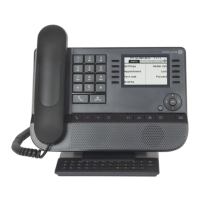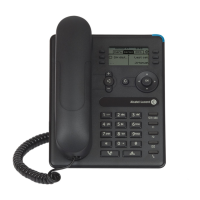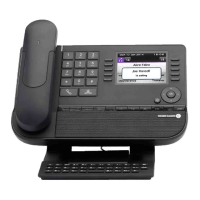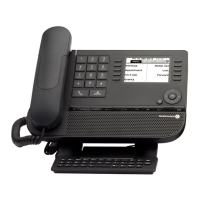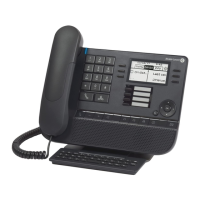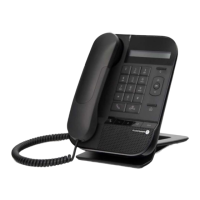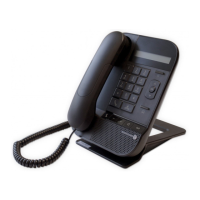Do you have a question about the Alcatel-Lucent 8028S and is the answer not in the manual?
Detailed description and features of the 8028s Premium DeskPhone model.
Detailed description and features of the 8018 DeskPhone model.
Overview of the phone's permanent function keys and their operations.
Explanation of the phone's default homepage and its displayed information.
Guide to using navigation keys for menu and feature access.
Explanation of icons displayed on the screen for call status and phone configuration.
Details on the phone's alphabetic and numeric keyboard layout and usage.
Information on the different connectors available on the phone models.
Instructions for correctly installing a wired telephone handset.
Managing contacts within the phone's local directory for easy access.
Viewing and interacting with individual contact details and history.
Displaying phone status, missed calls, messages, and forwarding status.
Consulting and managing the history of incoming, outgoing, and missed calls.
Instructions for initiating calls by directly dialing a phone number.
Making calls by searching for contacts in the company directory by name.
Re-calling contacts directly from the call log history.
Initiating calls by selecting contacts from the local directory.
Procedures for answering, rejecting, or deflecting incoming calls.
Changing audio output between handset, headset, loudspeaker, or hands-free.
Using the loudspeaker function during an active call.
Redialing the last dialed number for quick callbacks.
Sending DTMF tones for automated systems or interactive voice response.
Disabling the microphone to prevent the other party from hearing you.
Initiating a new call while already engaged in a conversation.
Handling an incoming call while on an active call.
Ending a second call and returning to the first active call.
Temporarily suspending an active call and resuming it later.
Alternating between active and held calls.
Redirecting an active call to another number or contact.
Setting up and managing a conference call with multiple participants.
Configuring the phone to mask the caller's identity during outgoing calls.
Temporarily making the phone unavailable for incoming calls.
Setting up call forwarding rules for various scenarios like absence or busy.
Accessing and listening to voice messages received on the phone.
Configuring ringtones, melodies, and ringer volume levels.
Setting the incoming call ringer volume.
Defining the default screen and tab order displayed on the phone.
Changing the display language of the phone's interface.
Modifying the display contrast for better readability.
Adjusting screen brightness for both active and idle phone states.
Assigning functions or contacts to programmable keys for quick access.
Connecting and configuring audio accessories via the phone's jack port.
Connecting and configuring audio accessories via the phone's USB port.
Managing audio accessories connected via USB and jack ports.
Information on how to contact technical support and find phone codes.
Essential safety precautions for operating the telephone equipment.
Information regarding regulatory compliance, RF exposure, and product usage.
Detailed description and features of the 8028s Premium DeskPhone model.
Detailed description and features of the 8018 DeskPhone model.
Overview of the phone's permanent function keys and their operations.
Explanation of the phone's default homepage and its displayed information.
Guide to using navigation keys for menu and feature access.
Explanation of icons displayed on the screen for call status and phone configuration.
Details on the phone's alphabetic and numeric keyboard layout and usage.
Information on the different connectors available on the phone models.
Instructions for correctly installing a wired telephone handset.
Managing contacts within the phone's local directory for easy access.
Viewing and interacting with individual contact details and history.
Displaying phone status, missed calls, messages, and forwarding status.
Consulting and managing the history of incoming, outgoing, and missed calls.
Instructions for initiating calls by directly dialing a phone number.
Making calls by searching for contacts in the company directory by name.
Re-calling contacts directly from the call log history.
Initiating calls by selecting contacts from the local directory.
Procedures for answering, rejecting, or deflecting incoming calls.
Changing audio output between handset, headset, loudspeaker, or hands-free.
Using the loudspeaker function during an active call.
Redialing the last dialed number for quick callbacks.
Sending DTMF tones for automated systems or interactive voice response.
Disabling the microphone to prevent the other party from hearing you.
Initiating a new call while already engaged in a conversation.
Handling an incoming call while on an active call.
Ending a second call and returning to the first active call.
Temporarily suspending an active call and resuming it later.
Alternating between active and held calls.
Redirecting an active call to another number or contact.
Setting up and managing a conference call with multiple participants.
Configuring the phone to mask the caller's identity during outgoing calls.
Temporarily making the phone unavailable for incoming calls.
Setting up call forwarding rules for various scenarios like absence or busy.
Accessing and listening to voice messages received on the phone.
Configuring ringtones, melodies, and ringer volume levels.
Setting the incoming call ringer volume.
Defining the default screen and tab order displayed on the phone.
Changing the display language of the phone's interface.
Modifying the display contrast for better readability.
Adjusting screen brightness for both active and idle phone states.
Assigning functions or contacts to programmable keys for quick access.
Connecting and configuring audio accessories via the phone's jack port.
Connecting and configuring audio accessories via the phone's USB port.
Managing audio accessories connected via USB and jack ports.
Information on how to contact technical support and find phone codes.
Essential safety precautions for operating the telephone equipment.
Information regarding regulatory compliance, RF exposure, and product usage.
| Navigation | 4-way navigation key |
|---|---|
| Bluetooth | No |
| USB | No |
| Codecs | G.711, G.729, G.722 |
| Connectivity | Ethernet 10/100 Mbps |
| Audio | HD Audio |
| Power | PoE (Power over Ethernet) IEEE 802.3af |
| Ports | Headset port |
| Protocols | SIP |
| Headset Port | Yes |
| Lines | 6 |
| Handset | Hearing Aid Compatible (HAC) |
| Speakerphone | Full duplex |
| Dimensions | 200 x 200 x 70 mm |
| Resolution | 240x320 pixels |

